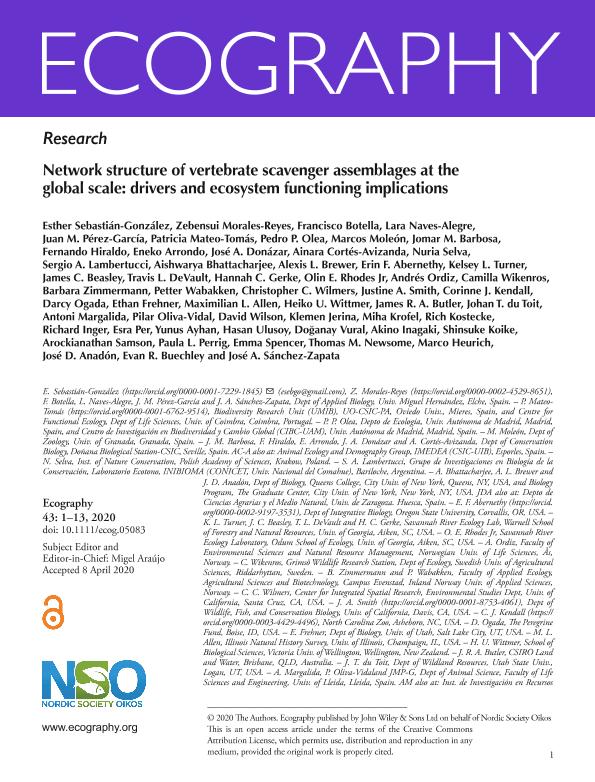Artículo
Network structure of vertebrate scavenger assemblages at the global scale: Drivers and ecosystem functioning implications
Sebastián González, Esther; Morales Reyes, Zebensui; Botella, Francisco; Naves Alegre, Lara; Pérez García, Juan M.; Mateo Tomás, Patricia; Pérez Olea, Pedro; Moleón, Marcos; Barbosa, Jomar M.; Hiraldo, Fernando; Arrondo, Eneko; Donázar, José Antonio; Cortés Avizanda, Ainara; Selva, Nuria; Lambertucci, Sergio Agustin ; Bhattacharjee, Aishwarya; Brewer, Alexis L.; Abernethy, Erin F.; Turner, Kelsey L.; Beasley, James C.; DeVault, Travis L.; Gerke, Hannah C.; Rhodes, Olin E.; Ordiz, Andrés; Wikenros, Camilla; Zimmermann, Barbara; Wabakken, Petter; Wilmers, Christopher C.; Smith, Justine A.; Kendall, Corinne J.
; Bhattacharjee, Aishwarya; Brewer, Alexis L.; Abernethy, Erin F.; Turner, Kelsey L.; Beasley, James C.; DeVault, Travis L.; Gerke, Hannah C.; Rhodes, Olin E.; Ordiz, Andrés; Wikenros, Camilla; Zimmermann, Barbara; Wabakken, Petter; Wilmers, Christopher C.; Smith, Justine A.; Kendall, Corinne J.
 ; Bhattacharjee, Aishwarya; Brewer, Alexis L.; Abernethy, Erin F.; Turner, Kelsey L.; Beasley, James C.; DeVault, Travis L.; Gerke, Hannah C.; Rhodes, Olin E.; Ordiz, Andrés; Wikenros, Camilla; Zimmermann, Barbara; Wabakken, Petter; Wilmers, Christopher C.; Smith, Justine A.; Kendall, Corinne J.
; Bhattacharjee, Aishwarya; Brewer, Alexis L.; Abernethy, Erin F.; Turner, Kelsey L.; Beasley, James C.; DeVault, Travis L.; Gerke, Hannah C.; Rhodes, Olin E.; Ordiz, Andrés; Wikenros, Camilla; Zimmermann, Barbara; Wabakken, Petter; Wilmers, Christopher C.; Smith, Justine A.; Kendall, Corinne J.
Fecha de publicación:
08/2020
Editorial:
Wiley Blackwell Publishing, Inc
Revista:
Ecography
ISSN:
0906-7590
Idioma:
Inglés
Tipo de recurso:
Artículo publicado
Clasificación temática:
Resumen
The organization of ecological assemblages has important implications for ecosystem functioning, but little is known about how scavenger communities organize at the global scale. Here, we test four hypotheses on the factors affecting the network structure of terrestrial vertebrate scavenger assemblages and its implications on ecosystem functioning. We expect scavenger assemblages to be more nested (i.e. structured): 1) in species-rich and productive regions, as nestedness has been linked to high competition for carrion resources, and 2) regions with low human impact, because the most efficient carrion consumers that promote nestedness are large vertebrate scavengers, which are especially sensitive to human persecution. 3) We also expect climatic conditions to affect assemblage structure, because some scavenger assemblages have been shown to be more nested in colder months. Finally, 4) we expect more organized assemblages to be more efficient in the consumption of the resource. We first analyzed the relationship between the nestedness of the scavenger assemblages and climatic variables (i.e. temperature, precipitation, temperature variability and precipitation variability), ecosystem productivity and biomass (i.e. NDVI) and degree of human impact (i.e. human footprint) using 53 study sites in 22 countries across five continents. Then, we related structure (i.e. nestedness) with its function (i.e. carrion consumption rate). We found a more nested structure for scavenger assemblages in regions with higher NDVI values and lower human footprint. Moreover, more organized assemblages were more efficient in the consumption of carrion. However, our results did not support the prediction that the structure of the scavenger assemblages is directly related to climate. Our findings suggest that the nested structure of vertebrate scavenger assemblages affects its functionality and is driven by anthropogenic disturbance and ecosystem productivity worldwide. Disarray of scavenger assemblage structure by anthropogenic disturbance may lead to decreases in functionality of the terrestrial ecosystems via loss of key species and trophic facilitation processes.
Palabras clave:
CARRION
,
CONSUMPTION RATE
,
ECOLOGICAL NETWORKS
,
GLOBAL CHANGE
,
MACROECOLOGY
,
NDVI
Archivos asociados
Licencia
Identificadores
Colecciones
Articulos(INIBIOMA)
Articulos de INST. DE INVEST.EN BIODIVERSIDAD Y MEDIOAMBIENTE
Articulos de INST. DE INVEST.EN BIODIVERSIDAD Y MEDIOAMBIENTE
Citación
Sebastián González, Esther; Morales Reyes, Zebensui; Botella, Francisco; Naves Alegre, Lara; Pérez García, Juan M.; et al.; Network structure of vertebrate scavenger assemblages at the global scale: Drivers and ecosystem functioning implications; Wiley Blackwell Publishing, Inc; Ecography; 43; 8; 8-2020; 1143-1155
Compartir
Altmétricas



